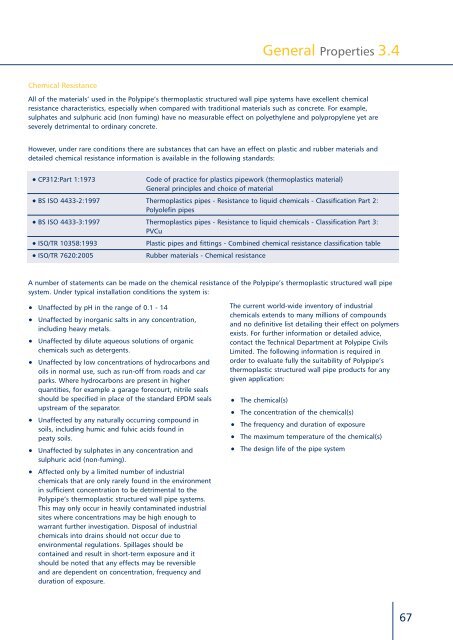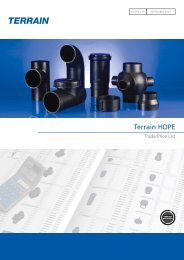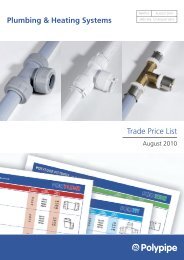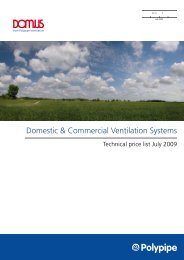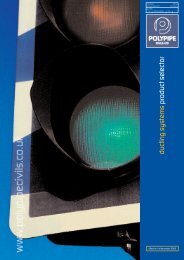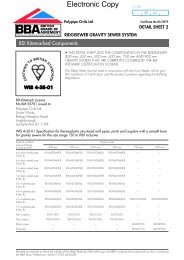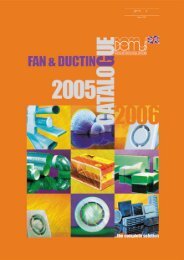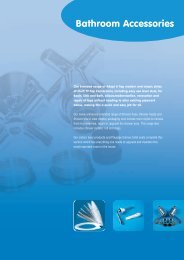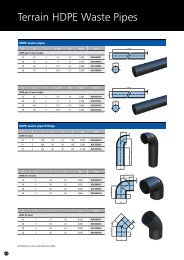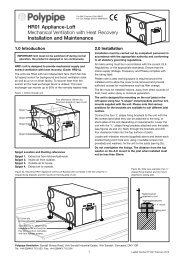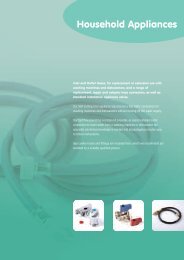advanced drainage system - Polypipe
advanced drainage system - Polypipe
advanced drainage system - Polypipe
You also want an ePaper? Increase the reach of your titles
YUMPU automatically turns print PDFs into web optimized ePapers that Google loves.
General Properties 3.4<br />
Chemical Resistance<br />
All of the materials’ used in the <strong>Polypipe</strong>’s thermoplastic structured wall pipe <strong>system</strong>s have excellent chemical<br />
resistance characteristics, especially when compared with traditional materials such as concrete. For example,<br />
sulphates and sulphuric acid (non fuming) have no measurable effect on polyethylene and polypropylene yet are<br />
severely detrimental to ordinary concrete.<br />
However, under rare conditions there are substances that can have an effect on plastic and rubber materials and<br />
detailed chemical resistance information is available in the following standards:<br />
• CP312:Part 1:1973<br />
Code of practice for plastics pipework (thermoplastics material)<br />
General principles and choice of material<br />
• BS ISO 4433-2:1997 Thermoplastics pipes - Resistance to liquid chemicals - Classification Part 2:<br />
Polyolefin pipes<br />
• BS ISO 4433-3:1997 Thermoplastics pipes - Resistance to liquid chemicals - Classification Part 3:<br />
PVCu<br />
• ISO/TR 10358:1993<br />
• ISO/TR 7620:2005<br />
Plastic pipes and fittings - Combined chemical resistance classification table<br />
Rubber materials - Chemical resistance<br />
A number of statements can be made on the chemical resistance of the <strong>Polypipe</strong>’s thermoplastic structured wall pipe<br />
<strong>system</strong>. Under typical installation conditions the <strong>system</strong> is:<br />
• Unaffected by pH in the range of 0.1 - 14<br />
• Unaffected by inorganic salts in any concentration,<br />
including heavy metals.<br />
• Unaffected by dilute aqueous solutions of organic<br />
chemicals such as detergents.<br />
• Unaffected by low concentrations of hydrocarbons and<br />
oils in normal use, such as run-off from roads and car<br />
parks. Where hydrocarbons are present in higher<br />
quantities, for example a garage forecourt, nitrile seals<br />
should be specified in place of the standard EPDM seals<br />
upstream of the separator.<br />
• Unaffected by any naturally occurring compound in<br />
soils, including humic and fulvic acids found in<br />
peaty soils.<br />
• Unaffected by sulphates in any concentration and<br />
sulphuric acid (non-fuming).<br />
• Affected only by a limited number of industrial<br />
chemicals that are only rarely found in the environment<br />
in sufficient concentration to be detrimental to the<br />
<strong>Polypipe</strong>’s thermoplastic structured wall pipe <strong>system</strong>s.<br />
This may only occur in heavily contaminated industrial<br />
sites where concentrations may be high enough to<br />
warrant further investigation. Disposal of industrial<br />
chemicals into drains should not occur due to<br />
environmental regulations. Spillages should be<br />
contained and result in short-term exposure and it<br />
should be noted that any effects may be reversible<br />
and are dependent on concentration, frequency and<br />
duration of exposure.<br />
The current world-wide inventory of industrial<br />
chemicals extends to many millions of compounds<br />
and no definitive list detailing their effect on polymers<br />
exists. For further information or detailed advice,<br />
contact the Technical Department at <strong>Polypipe</strong> Civils<br />
Limited. The following information is required in<br />
order to evaluate fully the suitability of <strong>Polypipe</strong>’s<br />
thermoplastic structured wall pipe products for any<br />
given application:<br />
• The chemical(s)<br />
• The concentration of the chemical(s)<br />
• The frequency and duration of exposure<br />
• The maximum temperature of the chemical(s)<br />
• The design life of the pipe <strong>system</strong><br />
67


